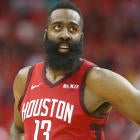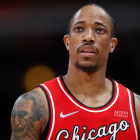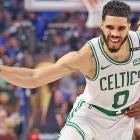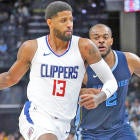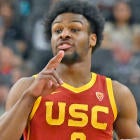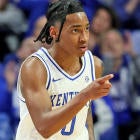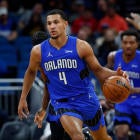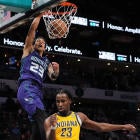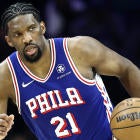These tiers assume eight category settings. Within each tier, players are listed in recommended draft order:
Tier 1: Potential first overall picks
There are five players worth considering with the first overall pick this season. In my own personal ranks, I have Harden third, but I wouldn't complain about any ordering of the five. Harden has been the top-ranked player in 8-cat leagues for each of the past three seasons, but I have him downgraded slightly because I'm somewhat concerned about how the addition of Russell Westbrook will impact him. One major factor in Harden's favor, however, is his shooting guard eligibility. Shooting guard is easily the shallowest position in Fantasy, and Harden is the only SG-eligible player of the top five. In drafting Harden, you are locking down a season-long advantage over all your opponents, and the biggest such positional advantage possible.
Tier 2: Late first-round values
Bradley Beal, Wizards
Jimmy Butler, Heat
Beal is likely to be a popular pick in the seven-to-nine range, especially in roto leagues. The biggest concern most people have is that Beal might miss a lot of late-season games after the Wizards are inevitably eliminated from playoff contention. That's a legitimate concern in head-to-head leagues, but there are so many other risky picks in this range of the draft that I'd still take Beal in the first round. He finished in the top 15 last year and was a top-10 player over the final two months of the season.
The Fantasy community is much more split on Butler. He'll go seventh in some leagues, but in others he might come off the board after the two names in Tier 3. Frankly, I don't understand the doubt. He poses some injury risk – thanks, Thibs – but so does almost everyone else getting drafted between picks seven and 25. And in an offseason that saw huge names moving all across the league, Butler is one of the few stars who landed in an unequivocally better Fantasy situation than the one he left.
Butler finished inside the top 15 in 2016-17 and 2017-18, when his usage rates were 27% and 25%, respectively. Both his ranking and his usage rate fell as a member of the 76ers. Now, he'll be the focal point of the Heat's offense.
Tier 3: The minefield
Devin Booker, Suns
Jrue Holiday, Pelicans
I've never been able to get excited about Devin Booker, but the Suns' addition of Ricky Rubio has me reconsidering. Rubio is one of the best passers in the league, with the vision and finesse to force teammates open. He will be, by far, the best point guard Booker has ever played alongside. Rubio's presence should boost Booker's scoring and efficiency, even if it means Booker sacrifices a few assists per game. There's still some risk, as there is with every player in this range of the draft. In order to join the already-deep group of playoff contenders, the Suns would need a turnaround more surprising than what the Kings pulled off last season. And when the Suns don't make the playoffs, all their young players magically come down with mysterious ailments.
Holiday has a proven track record of top-20 finishes, but the Pelicans' offseason moves could prove problematic. Holiday was fifth in the NBA in minutes in 2018-19, and the Pelicans acquired three players who are best used as point guards and two who are best used as shooting guards. Holiday is still the leader of the team, but he could realistically play five fewer minutes per game and still hold that title.
Tier 4: The last really good options
DeMar DeRozan, Spurs
Buddy Hield, Kings
Donovan Mitchell, Jazz
C.J. McCollum, Trail Blazers
Jamal Murray, Nuggets
There's a lot to like in this tier. DeRozan is a fixture in the top 40. His ceiling and his floor are the same. Hield is likely to finish among the league-leaders in threes, he doesn't hurt in any category, and he's young enough that he could still improve upon last season's top-50 finish. McCollum could be a steal this late in drafts – his slow start in 2018-19 remains a concern, but he put up top-25 numbers after the All-Star break. McCollum is similar to DeRozan in that he has almost no chance of cracking the top 30, but he's almost equally unlikely to fall outside the top 50.
Meanwhile, Murray's ADP will probably rise as we get closer to the season, fueled by conversations about his massive contract extension. But remember, GMs don't decide the rotation, coaches do. Murray is crucial piece for the Nuggets, but they have a frighteningly deep backcourt. If Murray rises above last season's top-65 finish, it will be because he improved as a player, not because of an increase in minutes. That said, he's only 22 and improvement seems likely.
Mystery Tier: Victor Oladipo
Victor Oladipo, Pacers
In head-to-head leagues with an IR spot and daily lineups, this is where I'd put Oladipo. But in some league formats, he shouldn't be a top-90 pick. Oladipo should also be avoided if you've already drafted a couple players with particularly concerning injury histories like Anthony Davis, Joel Embiid, Kyrie Irving, Kevin Love or Chris Paul.
We don't really know when Oladipo will return, but the optimistic reports suggest he could be back before early December. He's had a top-10 season and two seasons in which he finished inside the top 35, so there is a ton of upside if he can be the same caliber of player he was pre-injury. Wherever you select Oladipo, it is a risk. Where you're willing to draft him depends on your league settings, how much risk you are willing to tolerate, and whether you think he can return to his pre-injury production.
Tier 5: Slightly overrated
D'Angelo Russell, Warriors
Zach LaVine, Bulls
This is lower than most analysts would rank this pair. If you want to draft either, you're probably going to have to consider them in the top half of Tier 4. I've tried to be fair in the analysis below, but if you really want to understand why people are taking these two inside the top 50, or even the top 40 in some cases, you'll probably have to look elsewhere.
Russell should see plenty of minutes in the Warriors' spartan backcourt. But he already averaged 30.2 MPG last season, and in Golden State, his 32 percent usage rate is likely to fall precipitously. He's a drain on field-goal percentage, he doesn't help in free-throw percentage, and his assists will probably drop playing alongside Steph Curry and Draymond Green. Overall, I view his 2019-20 Fantasy situation as less favorable than his 2018-19 Fantasy situation. On top of that, the Warriors have openly discussed the possibility of trading Russell, which is a level of uncertainty I'd rather avoid. Any optimism about his prospects this season rests primarily on his top-35 finish a year ago, the likelihood that his minutes will increase, and the hope that teaming up with Curry helps his efficiency.
Like Russell, LaVine finished inside the top-35 last season. And like LaVine, his overall Fantasy situation appears to have gotten worse. Lauri Markkanen and Wendell Carter missed a combined 68 games, and they are likely to take away a significant number of LaVine's shots and rebounds. The Bulls were weakest at point guard last season, inflating LaVine's assist numbers, and that has been partly remedied by the additions of Tomas Satoransky and 2019 lottery pick Coby White. LaVine is still likely to be one of the highest scorers left on the board whenever he gets drafted, and he doesn't really hurt in any category.
The best thing I can say about Russell and LaVine? They are both miles better than any of the shooting guards below.
Tier 6: Technically 6 comes after 5, but this is more like Tier 8
Josh Richardson, 76ers
If you are in a league with restrictive positional settings, this is your last chance to draft a reliable starting shooting guard. Richardson is a heck-of-a-lot worse than anyone in the top five tiers, but he's also a safe bet to finish inside the top-100 – and he'll probably finish a lot higher than that. If you miss out on Richardson, you may end up regularly starting someone who is stuck on the bench in less restrictive leagues.
Richardson's value took a big hit after he joined the loaded 76ers, who have arguably the best starting unit in the league. He's finished inside the top-75 in each of the last two seasons, and he has the potential to provide 1-1-1 value (at least one three, one steal and one block per game) depending on how he's used on defense. His field goal percentage has fluctuated wildly through his career, but it's likely to swing back up now that he's the fourth or fifth option. The flip side of that, of course, is his overall scoring might take a hit.
Tier 7: If the last one was Tier 8, this is more like Tier 11
Marcus Smart, Celtics
Terrence Ross, Magic
J.J. Redick, Pelicans
Brandon Ingram, Pelicans
All four of these guys are borderline top-100 players with the potential to rise into the top 80 or fall outside the top 130. The Celtics' backcourt is less clogged than it has been in years, but a slight drop in steals or shooting efficiency could tank Smart's upside. Ross and Evan Fournier (Tier 9) are somewhat redundant, both in Fantasy and in the Magic's rotation, but Ross was the more valuable Fantasy play last season thanks to his improved three-point shooting. He'll provide value if he takes some of Fournier's minutes, and he'll fall to the waiver wire if the three-point shooting flips.
Redick only falls this low because of the Pelicans' severely overloaded depth chart, but we all expect them to figure out a way to get him minutes, right? At least we think? How old is he again? Speaking of the Pelicans, Ingram is a more dynamic player than Redick, but he's also coming off some serious health issues and "dynamic" doesn't always translate to more wins.
Tier 8: Lots of upside
Jaylen Brown, Celtics
Gary Harris, Nuggets
Nic Batum, Hornets
Andrew Wiggins, Timberwolves
Danny Green, Lakers
Caris LeVert, Nets
These players are going to fall in drafts, and with good reason. But all of them have top-100 potential. Harris and Batum were not only top-100, but top-60 guys in recent years. With that said, Harris fell off a cliff last season, and the surrounding depth chart is only getting stronger. Batum might be the best remaining player on the Hornets' roster, but he's an old 30, showing significant signs of decline as he enters his 12th NBA season.
We know Wiggins can score, but can he do anything else? Brown and LeVert appear in line for increased opportunities this season, but they'll have to improve upon their per-36 production in order to become true Fantasy assets. Finally, how much will the Lakers rely on Green? Anything from 24 to 35 minutes per game wouldn't surprise me.
Tier 9: The remainders
Lou Williams, Clippers
Evan Fournier, Magic
Kevin Huerter, Hawks
Joe Harris, Nets








